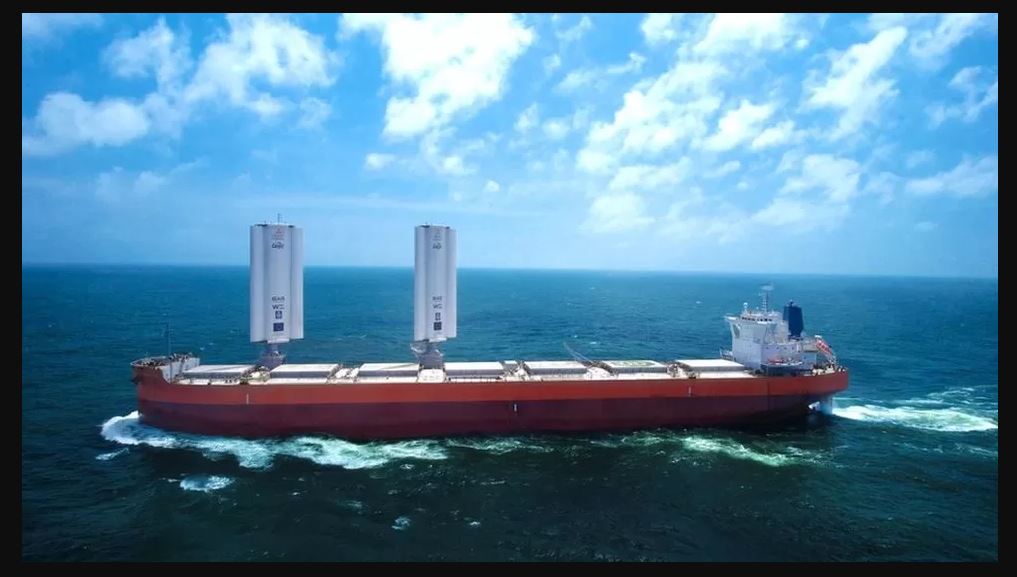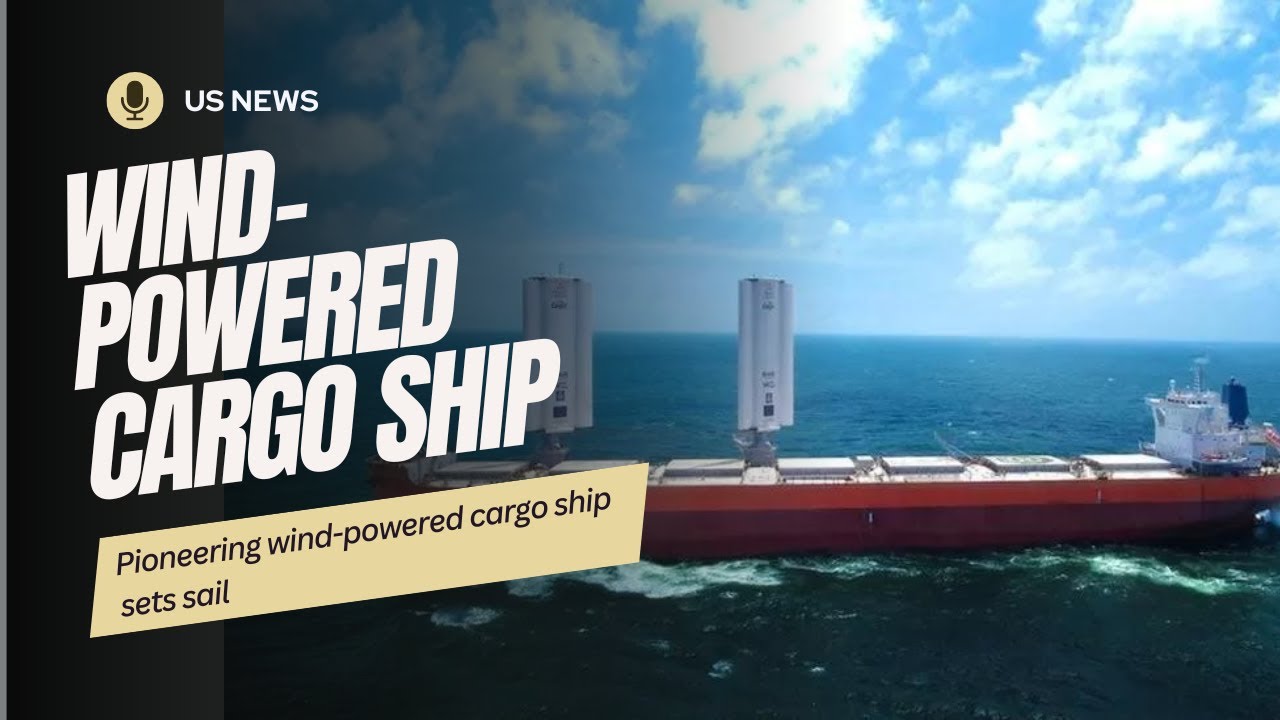First Ever Cargo Ship Powered By Wind Begins Its Journey
First ever cargo ship powered by wind begins its journey after being equipped with large and sturdy sails of British design. Cargill, a shipping company that has leased the vessel, envisions this innovation as a means to steer the industry towards a more environmentally friendly trajectory.
Author:Paolo ReynaReviewer:Hajra ShannonAug 22, 202380K Shares1M Views

The first ever cargo ship powered by wind begins its journeyafter being equipped with large and sturdy sails of British design. Cargill, a shipping company that has leased the vessel, envisions this innovation as a means to steer the industry towards a more environmentally friendly trajectory.
The innovative WindWings sails have been ingeniously crafted to curtail fuel usage, thereby reducing the carbon footprint of maritime shipping. Given that the shipping sector is believed to contribute roughly 2.1% of global carbon dioxide (CO2) emissions, this endeavor holds considerable promise.
The vessel named Pyxis Ocean is setting sail on its maiden voyage from China to Brazil, marking the first real-world trial of the WindWings technology. This voyage presents an opportunity to evaluate whether embracing traditional sail-propulsion methods could indeed be the future of maritime cargo transport.
When the ship is in port, the WindWings sails can be neatly folded down, and when out at sea, they unfurl to a towering height of 123 feet (37.5 meters). Constructed from the same robust materials used in wind turbines, these sails are built to endure the harsh marine environment.
By harnessing the power of wind to assist in propelling the vessel, rather than solely relying on its engines, it is anticipated that this innovation could potentially slash a cargo ship's cumulative emissions by up to 30% over its operational lifetime.
Jan Dieleman, the President of Cargill Ocean Transportation, remarked that the maritime industry is committed to the journey of decarbonization. While acknowledging that there is no one-size-fits-all solution, he emphasized that this technological leap underscores the rapid transformations taking place in the sector.
“„Five, six years ago, if you would ask people in shipping about decarbonisng, they would say 'well, it's going to be very difficult, I don't see this happening any time soon'. Five years later, I think the narrative has changed completely and everybody is really convinced that they need to do their part - everybody is just struggling a little on how we're going to do this. That's why we've taken the role as one of the larger players to underwrite some of the risk, and try things, and take the industry forward.- Jan Dieleman
The Pyxis Ocean's anticipated voyage to its destination is projected to span approximately six weeks. Interestingly, the technology being employed for this journey has its roots in a considerably swifter domain.
The innovation was conceived by the UK-based company BAR Technologies, which emerged as a separate entity from Sir Ben Ainslie's America's Cup team in 2017. The America's Cup, often likened to the 'Formula One of the seas,' served as the catalyst for the development of this technology.
"This is one of the most slow-moving projects we've done, but without doubt with the biggest impact for the planet," said John Cooper, who used to work for Formula One team McLaren.
He believes that this voyage has the potential to mark a pivotal moment for the maritime industry.
“„I do predict by 2025 half the new-build ships will be ordered with wind propulsion. The reason I'm so confident is our savings - one-and-a-half tonnes of fuel per day. Get four wings on a vessel, that's six tonnes of fuel saved, that's 20 tonnes of CO2 saved - per day. The numbers are massive.- John Cooper
While the innovation originates from the UK, the production of the wings themselves takes place in China. Mr. Cooper notes that the absence of government backing in terms of reducing the expenses associated with imported steel hinders the company's ability to manufacture the wings domestically.
"It's a shame, I'd love to build in the UK," he said.

Pioneering wind powered cargo ship sets sail
Devote All Available Resources
As the shipping sector endeavors to curtail its yearly output of approximately 837 million tonnes of CO2, experts highlight wind power as a promising avenue for exploration.
In July, the industry committed to achieving net-zero emissions of planet-warming gases "by or around 2050," a commitment that critics deemed insufficient.
Dr. Simon Bullock, a shipping researcher at the Tyndall Centre, situated at the University of Manchester, emphasizes the substantial potential of wind power. He notes that the emergence of cleaner fuels will take time, necessitating a comprehensive approach to operational enhancements for existing vessels. This includes retrofitting ships with innovations such as sails, kites, and rotors.
"Ultimately we do need zero-carbon fuels on all ships, but in the meantime, it is imperative to make every journey as efficient as possible. Slower speeds are also a critical part of the solution," he said.
Stephen Gordon, who serves as the Managing Director of the maritime data company Clarksons Research, concurred that technologies linked to wind power were indeed "gaining some traction."
“„We have the number of ships using this technology doubling over the past 12 months. This is from a low base, however. In the international shipping fleet and new-build order book of over 110,000 vessels, we have records for under 100 having wind-assisted technology today.- Stephen Gordon
Even if this figure experiences a substantial surge, it's worth noting that wind technology might not be viable for all types of vessels. For instance, situations where sails impede the process of unloading containers could present challenges.
"The shipping industry does not yet have a clear decarbonisation pathway and, given the scale the challenge and the diversity of the world shipping fleet, there is unlikely to be a single solution for the industry in the short or medium term," Mr Gordon predicted.
However, John Cooper from BAR Technologies holds a more optimistic outlook, asserting that the future of wind wings appears to be "very rosy." He also acknowledges a sense of gratification in the concept of the industry circling back to its origins.
"The engineers always hate it, but I always say it's back to the future," he said. "The invention of big combustion engines destroyed the trade routes and the sailing routes and now we're going to try to reverse that trend, just a bit."

Paolo Reyna
Author
Paolo Reyna is a writer and storyteller with a wide range of interests. He graduated from New York University with a Bachelor of Arts in Journalism and Media Studies.
Paolo enjoys writing about celebrity culture, gaming, visual arts, and events. He has a keen eye for trends in popular culture and an enthusiasm for exploring new ideas. Paolo's writing aims to inform and entertain while providing fresh perspectives on the topics that interest him most.
In his free time, he loves to travel, watch films, read books, and socialize with friends.

Hajra Shannon
Reviewer
Hajra Shannona is a highly experienced journalist with over 9 years of expertise in news writing, investigative reporting, and political analysis.
She holds a Bachelor's degree in Journalism from Columbia University and has contributed to reputable publications focusing on global affairs, human rights, and environmental sustainability.
Hajra's authoritative voice and trustworthy reporting reflect her commitment to delivering insightful news content.
Beyond journalism, she enjoys exploring new cultures through travel and pursuing outdoor photography
Latest Articles
Popular Articles